
Yasha: Legends of the Demon Blade Review
There’s a ton of competition in the roguelite isometric action RPG market these days. While Supergiant Games didn’t necessarily invent the foundations of the genre’s formula, Hades undoubtedly played a significant role in exposing and popularizing it. The inherent repetitive “run” loop of a roguelite tends to present problems in crafting a cohesive narrative that resonates with players, but Hades found a way to turn that structure into one of its core strengths.
The inspiration of Hades can be felt in many elements of Yasha: Legends of the Demon Blade. It seems as if developer 7QUARK wanted to create their own version of Hades, albeit on a smaller scale and with a focus on Japanese mythology. While it has the skeleton of a solid roguelite action RPG, Yasha is too barebones to truly make it a worthwhile experience.
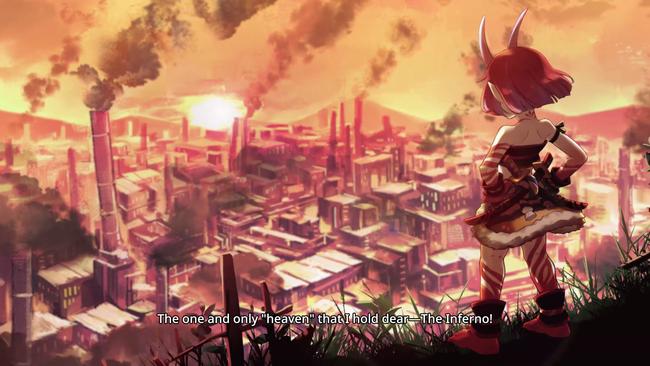
Right out of the gate, players can select from one of three playable protagonists - Shigure, Sara, and Taketora. Each character has their own unique weapons and storylines, though their paths to get to the end of their individual journeys are nearly identical. All of these characters’ stories consist of three chapters; fully completing one run completes a chapter and moves their story forward.
Every single run contains the same locations, the same bosses, and the same order of when the bosses appear. There are two battle arenas before each boss, and a rest checkpoint after each boss. Then, people will traverse through a new environment setting, completing the same loop of two arenas to the next boss.

Runs do contain a few structural variations. Some of the arena map layouts change, though they’re all still fairly small and condensed. Each rest checkpoint also randomizes which shop NPCs show up, so it’s entirely possible to be held back on purchasing useful, meaningful upgrades on a run because the shop NPC refuses to appear… and that doesn’t feel great. The final story chapter contains a new final boss, though this final boss is always the same for the three characters.
Each character’s initial first run tends to be their most dull, because players don’t gain access to the blacksmith until they succeed or fail their first run to respawn back in the starting village. Win or lose, players can spend some currency to unlock and/or upgrade weapons that will define the build and playstyle of their character.
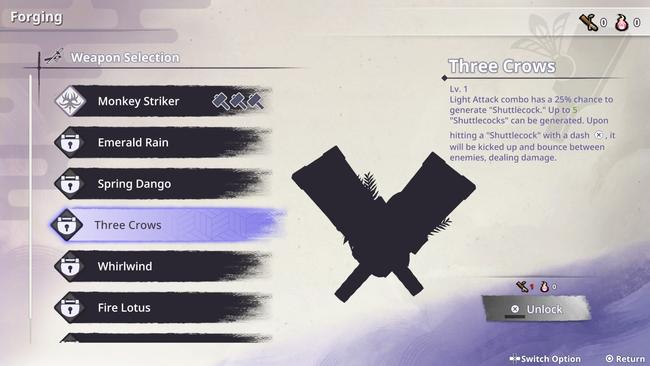
Shigure, for instance, has a katana that builds up a meter to create a flame circle around her, and another one that calls forth water projectiles. Other katanas may specialize in maximizing her Mystic Artes damage, which is the follow-up attack that characters can initiate upon a successful parry. After every battle encounter, there are orbs that provide three upgrade options for the character’s equipped weapons, and players can select one of them. Some of these are the typical damage upgrade options to light or heavy attacks, while others provide more interesting specialized properties, such as getting rid of the flame AoE circle in exchange for a powered-up state on the katana’s attacks that can inflict Burn and critical damage temporarily.
All three characters utilize the two weapons they can wield differently from one another. Shigure can immediately switch between her two katanas instantaneously, while Sara wields both of her weapons simultaneously. Meanwhile, Taketora can switch weapons, but his exclusive access to a ranged playstyle with the bow and arrow opens the door for build options that Shigure and Sara can’t use.
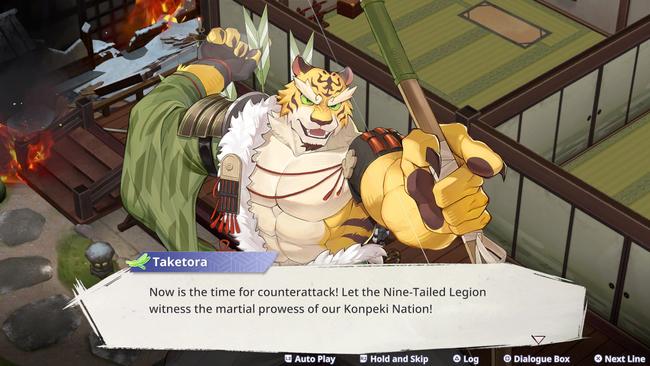
Mixing and matching different weapons, and exploring the synergistic possibilities that weapons can have with one another is where Yasha shines the most. Players can also invest in permanent upgrades when they respawn back at the village, whether it’s increasing a character’s base stats, or the probability that certain currencies are dropped by enemies, and such. Most of these permanent upgrades are dull, though there are a few interesting ones that are character exclusive, such as increasing the charge rate of the dash stamina meter.
At its best, Yasha is a game that allows for fun, unconventional builds. I had a run with Sara that did the bulk of her damage exclusively with dash attacks alone, and each of her dashes fired off a fiery bullet project that pierced and bounced between enemies and walls. On the other hand, I explored a chaotic build setup with Taketora that filled the screen with meteor explosions after my arrows connected with distant enemies.
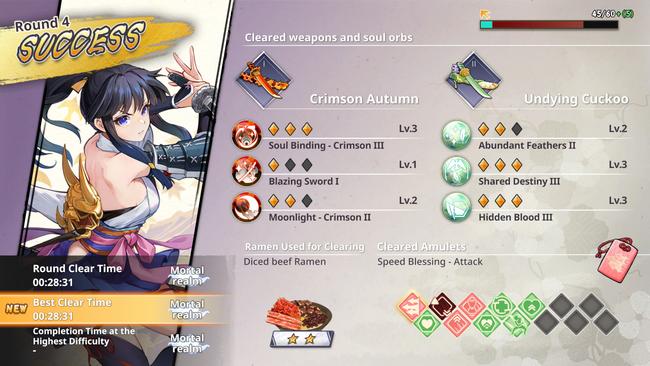
This doesn’t completely help rectify Yasha’s core issues of repetitiveness because, unlike Hades, there is no player agency in selecting a battle arena that’s focused on giving a certain resource - it’s completely linear all the way through. There are mini challenge stages that can only be attempted once at each rest checkpoint. These are timed encounters in which the player has to either defeat all the enemies or survive for a certain amount of time. They reward an amulet selection - one that is “safer”, and one that has a significant benefit that comes at a risk.
Perhaps the element that is most inspired by Hades in Yasha is how it handles its story. Each character’s story premise has a basic justification to continually make the same journey back to the Nine-Tailed Fox, who serves as the final boss up until the final story run. Shigure wants to slay the Nine-Tailed Fox for the atrocities it’s committed against her clan, while Sara has been exiled from her realm and must track down the mythical Okami to return to where she came from.
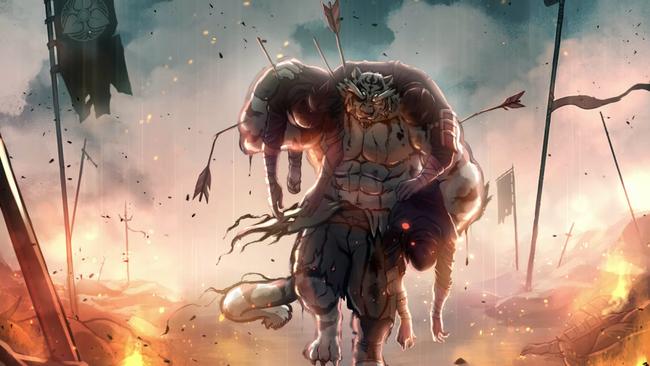
I find the narrative design and direction of each of the three main characters simple, but compelling because it’s told through an anthological lens. The events that transpire in them aren’t directly intertwined or connected in-between each other, yet similar characters do appear between them. It’s much like how the details of certain legends or myths can change when they’re shared via word-of-mouth; the characters mentioned in the various iterations of these tales may stay the same, but what they do or how they’re characterized may change as time goes on.
Yasha approaches this in a comparable fashion. For instance, Shigure appears in Sara and Taketora’s stories, but her background, her role, and her actions in their tales are very different from the storyline when she is the playable protagonist. It isn’t a matter of “where does this character’s storyline fit chronologically on a linear timeline”; instead, it’s a different version of a familiar tale altogether, and I find that oddly refreshing in a modern climate that’s so concerned with canon, linked universes, multiverses, and so on.
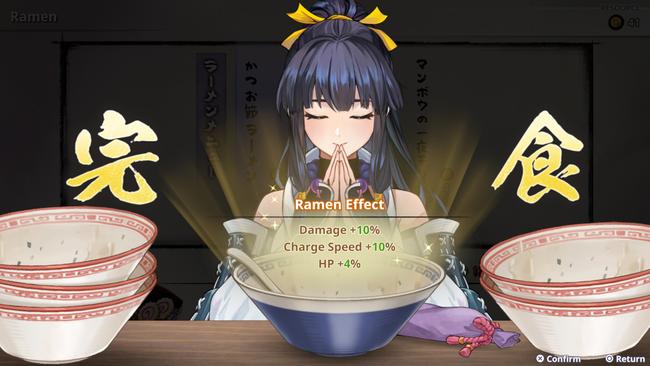
Even the stories themselves in-between each run have a unique angle. Shigure’s first chapter presents scenes and flashbacks of her childhood, while her second chapter examines these sequences from a different perspective to further illuminate the bigger picture. What starts out as a straightforward tale becomes one that becomes more intimate and emotional over time. Since the bosses remain the same, they have new story interactions and dialogue with Shigure as well. These bosses are framed and characterized differently both in subsequent runs, and with different characters, though sadly, the boss fights themselves change very little in terms of gameplay and how players approach them.
Despite my qualms, there is one key sequence in this game that left me unexpectedly in sheer awe. During one of Sara’s runs, there is a cutscene that occurs where she begins to perform a musical. The imagery that occurs during this is electrifying, with a vast variety of visual styles implemented during the lone musical sequence. One of those images is a parody of Shigure and Sara drawn as Beavis and Butthead, for example. I must’ve looked like a Looney Tunes character as my jaw dropped and my eyelids rose. I can’t remember the last time a video game got that kind of reaction out of me, so I will give major props to the art and sound team - this alone doesn’t fix the core issues I have with Yasha, but it was one hell of a surprise.
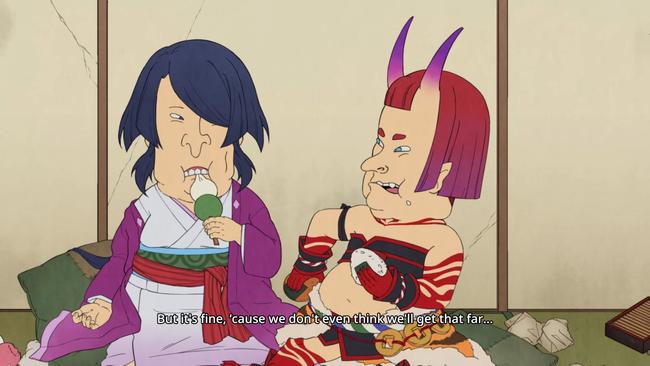
There are some disappointing English script typos and errors, too. Lengthy ability descriptions may not all fit in the merchant that sells them, and they don’t scroll to see the rest of it, so they’re cut off. Obvious wonky translations pop up here and there; Taketora’s prologue cutscene, for instance, has the following description verbatim:
Legend has it that whoever possesses the “The Cosmic Demon” shall gain the power to command all beings and unify the world.
Beyond that, there are some rudimentary gameplay design flaws that modern isometric action games have largely solved - yet are present in Yasha. Environmental assets, such as doors, completely obfuscate enemy models behind them. Therefore, players can’t make out what that enemy is doing, since they can’t see their animation start-ups, which can lead to some cheap hits. Most of Yasha’s contemporaries would usually include an outline of the enemy’s model to rectify this issue. Enemies often attack off-screen with no indicators, so projectiles or attacks that lunge forward often hit me when I wasn’t paying super close attention.

An average successful run in Yasha can go from 20-40 minutes, depending on how fast a player was able to get a decent build going and if the game allowed them to gain access to significant damage upgrades early on. Once a character’s story is finished, people can put self-imposed difficulty modifiers for greater rewards - which is very similar to the Heat system in Hades.
I rarely ever delve into whether a game is worth its asking price in reviews, because that is largely subjective. The asking price of Yasha is $30 USD, and I just personally feel that’s quite high from everything I’ve seen and experienced after fully completing the story of all three characters in 11 hours. There are some elements I certainly appreciated in Yasha, but I struggle to recommend it when there are other similar games in its space that are priced lower, such as Realm of Ink and Warm Snow, that generally have more meat on their bones for their reduced asking price.
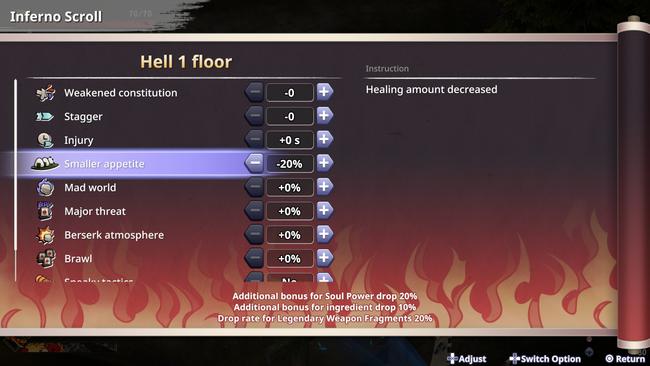
It’s a bummer that Yasha: Legends of the Demon Blade just feels sparse overall. While I enjoyed my time experimenting with each of the three protagonists’ different weapon synergies, the identical progression of every single run gets old very fast. Seeing the same stage layouts, same enemy spawns, same boss patterns, and same… everything every time was disheartening. Even when Yasha tries to punch above its weight narratively through some of its cutscenes, the whole experience of playing it is mind-numbingly repetitive. I wish I liked it more, but what it offers feels so little compared to many, many other games competing in the same Hades-like space.